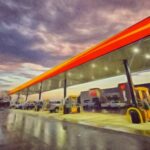
Moving on Truck Stops
January 26, 2024
The AI Caution
February 9, 2024How We Pay and Roll

Back to the Future?
Building on last week’s topic of building more truck stops, we dig a bit deeper and discover an entire world inside your checkout experience.
We know this QuikTrip in Kansas where the cashier pivots left and right to serve two lines of customers, all from the same register.
It’s a simple and brilliant play on perception. The line is essentially the same length, yet we sense we’re all the closer to paying and going.
The perception rings true, especially when you consider how long some people linger at the counter, counting their change, taking a sip of their Freezoni, rearranging the wallet, or otherwise just being vertical for a bit longer before getting back in the vehicle.
The National Association of Truck Stop Operators (NATCO) has been studying this. Their recent headline speaks volumes: “Increasing Your Travel Center’s Speed-of-Service Can Attract Drivers and Increase Sales.”
The customer experience informs so much of things anymore. It’s a terrific riff. We grow from transactions being about buying and selling and profit to how we buy, how we sell. And that tweaking of the experience has a proven record of increasing revenue.
NATSO conducts a study of truck stop and travel center owner-operators and drivers. They find value in offering loyalty programs (54% found a boost in non-fuel sales), cleanliness of showers and restrooms (reputation management; people talk about these things), and speed of service and personal interactions (two-thirds said this is essential).
The study also found:
- 81% have left a travel center with no purchase food or beverages.
- Most drivers tend to leave without buying anything if they saw five people in line.
- 13% will leave if they see just two people in line.
Which simmers up all sorts of ways to focus on the how of the experience. Example: Self-checkout attracts up to 30% of the customers.
As Darren Schulte, NATSO’s VP of membership, says, “If we lay stores out to make the customer experience, the speed of service and the ability to buy something easy, we will see higher conversion rates.”
A bit like moving freight from Point A to Point B without a traffic jam, yes?
